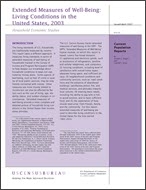Extended Measures of Well-Being: Living Conditions in the United States, 2003
Extended Measures of Well-Being: Living Conditions in the United States, 2003
Introduction
The living standards of U.S. households are traditionally measured by income.1 This report takes a different approach. It measures living standards in terms of extended measures of well-being of households tracked in the Survey of Income and Program Participation (SIPP) to help deepen our knowledge about household conditions in ways not captured by money alone. Some aspects of well-being, such as fear of crime or quality of local public services, may be only loosely connected with money. Other measures are more closely related to income but can also be effected by factors such as the cost of living, age, disability status, and sudden changes in circumstances. Extended measures of well-being provide a more complete and detailed picture of household living conditions in the United States than income alone provides.
The U.S. Census Bureau tracks extended measures of well-being in the SIPP.2 The SIPP’s “Extended Measures of Well-Being” topical module, on which this report is based, covers five broad domains: (1) appliances and electronic goods, such as possession of refrigerators, landline and cellular telephones, and computers; (2) housing conditions, including level of satisfaction with overall home repair, adequate living space, and sufficient privacy; (3) neighborhood conditions and community services, such as: road conditions and the presence of abandoned buildings; satisfactory police, fire, and medical services; and attitudes towards local schools; (4) meeting basic needs, including the ability to pay bills in full, to avoid eviction, and to have sufficient food; and (5) the expectation of help, should need arise, from friends, family, and the community. For this report, extended measures of well-being are used to describe living conditions in the United States for the time period 1992–2003.
_______________
1 For a discussion of the various aspects of well-being, see Supplemental Measures of Material Well-Being: Expenditures, Consumption, and Poverty 1998 and 2001, Current Population Reports, P23-201. U.S. Census Bureau, Washington, DC, 2003; Lever, Joaquina, et al. 2005, “Poverty, Psychological Resources and Subjective Well-Being.” Social Indicators Research, 73: 375-408; Diener, Ed & Eunkook Suh, 1997, “Measuring Quality of Life: Economic, Social, and Subjective Indicators,” Social Indicators Research. 40:189-216; Kahneman, D., E. Diener and N. Schwarz, Well-Being: the Foundations of Hedonic Psychology, New York: Russell-Sage, 1999. For more information on children’s well-being, see Jane Lawler Dye and Tallese Johnson, A Child’s Day: 2003 (Selected Indicators of Child Well-Being), Current Population Reports, P70-109, U.S. Census Bureau, Washington, DC, 2003.
2 The data from this report were collected June through September 2003 in the eighth wave (interview) of the 2001 Survey of Income and Program Participation, August through November in the eighth wave (interview) of 1998 the Survey of Income and Program Participation, and October 1992 through January 1993 in the sixth wave (interview) of the 1991 Survey of Income and Program Participation. The population represented (the population universe) is the civilian noninstitutionalized population of the United States.
Tables
Others in Series
Publication
Publication
Publication





